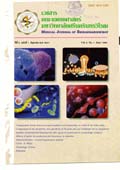สรีรวิทยาของการรับรส
Keywords:
สรีรวิทยา, ตัวรับรสAbstract
ตัวรับรสจัดเป็นตัวรับเชิงเคมีที่ถูกกระตุ้นได้ด้วยสารที่ละลายอยู่ในน้ำลายหรือของเหลวในช่องปากที่อาบอยู่โดยรอบ การรับรสแบ่งออกเป็น 4 ชนิด คือ รสหวาน รสเปรี้ยว รสเค็ม และรสขม กลไกการรับรสแต่ละชนิดจะแตกต่างกัน รสเค็มเกี่ยวข้องกับการเปิด so-dium channels ให้โซเดียมอิออนเคลื่อนเข้าสู่เซลล์ การยับยั้ง channels ของโปตัสเซียมหรือโซเดียมอิออนด้วยไฮโดรเจนอิออนทำให้เกิดการรับรสเปรี้ยว การรับรสขมและรสหวานจะผ่านทาง G protein ที่ชื่อว่า gustducin ซึ่งทำให้ปริมาณแคลเซียมอิออนภายในเซลล์เพิ่มขึ้นและยับยั้ง potassium channels ตามลำดับ เมื่อสารให้รสจับกับตัวรับบน microvilli จะก่อให้เกิดการสร้างสารสื่อภายในเซลล์และเปลี่ยนแปลงความต่างศักย์ กระตุ้นเซลล์ได้จนถึงภาวะ depolorization แล้วมีการหลั่งสารสื่อประสาทจากเซลล์รับรสด้วยวิธี synaptic exocytosis The taste (gustatory) receptor are classified as chemoreceptors excited by substances dissolved in saliva or oral fluids bathing them. Taste sensation can all be grouped into four basic qualities: sweet, sour, salty and bitter. The mechanism of taste transduction appears to have its own special mechanism for each taste.Salty taste seems to be due to sodium influx through sodium channels. Sour is madiated by hydrogen blockade of potassium or sodium channels. The bitter and sweet responses are midiated by G protein subunit, identified and named gustducin, that act to increase intracellular levels of calcium ion and inactivate potassium channels, respectively. The binding between tastant and receptor on the exposed microvill in the taste pore causes generation of intracellular messenger and change in membrane potential, depolarization. Thereby, general cell activation is attained. and finally, the release of neurotransmitter from taste cell causes excitation of sensory nerve fiber through synaptic exocytosis.Downloads
How to Cite
1.
สุภาพผล ร. สรีรวิทยาของการรับรส. J Med Health Sci [internet]. 2008 Sep. 10 [cited 2026 Jan. 15];5(1). available from: https://he01.tci-thaijo.org/index.php/jmhs/article/view/61789
Issue
Section
Review article (บทความวิชาการ)



